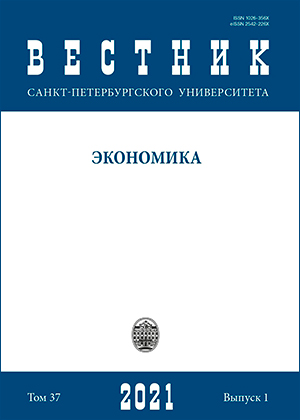Exchange rate regulation in economic unions: The case of Euroasian Economic Union
DOI:
https://doi.org/10.21638/spbu05.2021.106Abstract
This article explores currency regulation in the EAEU countries for the harmonization of currency policies in the context of economic integration. The object of the study is currency regulation in countries of Eurasian integration. The main hypothesis is that EAEU member countries are not ready for currency integration, due to the presence of many macroeconomic distortions in their economies. The authors assess the possibility of creating a monetary union by analyzing and evaluating key criteria for currency integration as known in the scholarly literature. For this goal, the authors conducted a literature review of the key prerequisites
for currency integration, including the experience in the countries of the Eurozone. Then the authors analyze currency regulation in EAEU countries for meeting key criteria for currency integration. At this stage, the authors evaluate key factors of currency integration by EAEU member countries. The theoretical and methodological basis of the study was classic and modern approaches in the field of monetary and currency regulation—in particular, the research of modern analysts of the International Monetary Fund, the largest Central Banks of the world, and well-known experts of the field. The research results showed the inexpediency of creating a currency union within the Euroasian economic space at this stage.
Keywords:
economic integration, monetary union, currency regulation, EAEU
Downloads
References
References
Aghion P., Bacchetta P., Ranciere R., Rogoff K. (2006) Exchange rate volatility and productivity growth:The role of financial development. NBER Working Paper, no. 12117, p. 48.
Alesina A., Barro R., Tenreyro S. (2002) Optimal Currency Areas. NBER Working Paper, no. 9072, p. 49.
Aristotelous K., Fountas S. (2012) What is the Impact of Currency Unions on FDI Flows? Evidence from Eurozone Countries. South-Eastern Europe Journal of Economics, vol. 2, pp. 87–98.
Bergin P. R., Lin Ch. Y. (2010) The dynamic effects of currency union on trade. Coventry: Department of Economics, University of Warwick. CAGE Online Working Paper Series, vol. 2010, no. 11, p. 46.
Bertolla G. (1989) Factor Flexibility, Uncertainty and Exchange Rate Regimes. A European Central Bank,pp. 95–119
Blaise G., Aaron M. (2013) The exchange rate, real economy and financial markets. BIS Papers, no. 73,pp. 11–23.
Canofari P., Marini G., Piersanti G. (2012) The sustainability of monetary unions. Can the Euro survive? CEIS Working Paper, no. 226, p. 11.
Cheung Y. W., Pascual A. G. (2004) Testing for output convergence: a re-examination. Oxford Economic Papers, no. 56, pp. 45–63.
Corden W. (1973). The Adjustment Problem. European Monetary Unification and Its Meaning for the United States. Eds L. B. Krause and W. S. Salant. Washington, The Brookings Institution., pp. 159–184.
De Grauwe P. (2003) Economics of monetary union. 5th ed. Oxford University Press, Oxford, UK. 258 p.
De Grauwe P. (2006) On monetary and political union. CESifo Forum, no. 4, pp. 3–10.
Dimitrios S., Nicholas T. (2014) Exchange Rate Volatility and Aggregate Exports: Evidence from Two Small Countries. Hindawi Publishing Corporation, ISRN Economics, pp. 1–10.
Edwards S., Magendzo I. (2006) Strict Dollarization and Economic Performance: An Empirical Investigation. Journal of Money, Credit and Banking, vol. 38, pp. 269–282. https://doi.org/10.1353/mcb.2006.0016.
Fleming J. (1971) On Exchange Rate Unification. Economic Journal, no. 81, pp. 467–488.
Frankel J., Rose A. (1998) The Endogeneity of the Optimum Currency Area Criteria. The Economic Journal,vol. 108, no. 449, pp. 1009–1025.
Fukuda H. (2002) The theory of Optimum Currency Areas. Keio University, pp. 1–17.
Ingram J. C. (1969) Comment: The Currency Area Problem. Monetary Problems of The International Economy. Ed. Robert A. Mundell and Alexander L. Swoboda. The University of Chicago Press, Chicago,pp. 95–100.
Kenen P. (1969) The Theory of Optimum Currency Areas: An Eclectic View. Monetary Problems of the International Economy. Ed. Mundell R. and Swoboda. The University of Chicago Press, Chicago,pp. 41–60.
Krugman P. (1991) Target Zones and Exchange Rate Dynamics. The Quarterly Journal of Economics, vol. 106,no. 3, pp. 669–682.
Krugman P., Obstfeld M. (2003) International Economics: Theory and Policy. Addison Wesley. 754 p.
Lipinska A., Thadden L. (2012) On the (In)Effectiveness of Fiscal Devaluations in a Monetary Union. SSRN Electronic Journal, pp. 1–46. https://doi.org/10.2139/ssrn.2195201.
McKinnon R. (1963) Optimum Currency Areas. American Economic Review, no. 53, pp. 717–725.
Mundell R. (1961) A Theory of Optimal Currency Areas. American Economic Review, no. 51, pp. 657–665.
Rose A. (2000) One money, one market: Estimating the effect of common currencies on trade. Economic Policy, no. 30, pp. 9–45.
Rose A. (2008) Is EMU becoming an optimum currency area? The evidence on trade and business cycle synchronization. Haas School of Business. University of California, Berkeley, pp. 1–16.
Rose A., Engel Ch. (2002) Currency unions and international integration. Journal of Money, Credit, and Banking, vol. 34, no. 4, pp. 1067–1089.
Rose A., Stanley T. (2005) A meta-analysis of the effect of common currencies on International Trade.Journal of Economic Surveys, no. 19, pp. 347–365.
Schnabl G. (2009) Exchange rate volatility and growth in emerging Europe and East Asia. Open Economies Review, vol. 20, no. 4, pp. 565–587.
Vaubel R. (1976) Real Exchange Rate Changes in the European Community: The Empirical Evidence and Its Implications for European Currency Unification. Weltwirtshaftliches Archive, no. 112, pp. 429–470
Downloads
Published
How to Cite
Issue
Section
License
Articles of the St Petersburg University Journal of Economic Studies are open access distributed under the terms of the License Agreement with Saint Petersburg State University, which permits to the authors unrestricted distribution and self-archiving free of charge.






